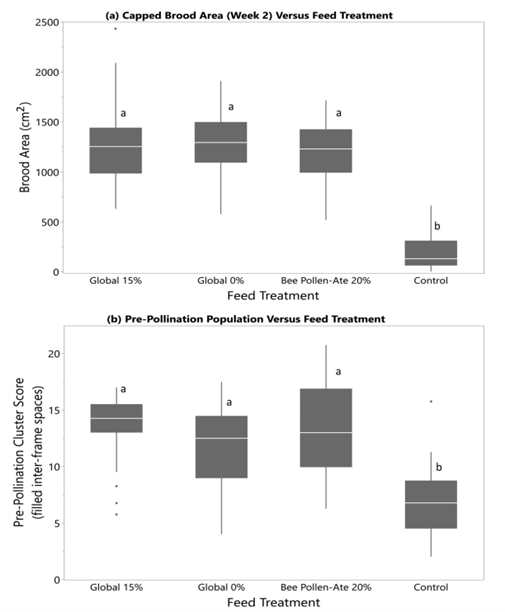With days lengthening and temperatures gradually rising, spring is on its way! As beekeepers begin opening colonies in the coming weeks, we will be presented with the decision of whether to provide bees with supplemental feed. To help in this decision, this week’s blog considers the findings of a newly published article from researchers in Alberta examining the benefits of supplemental protein feeding.
Supplemental Spring Protein Feeding
There are many options available for honey bee protein supplements, containing varying amounts of proteins, amino acids, lipids and carbohydrates. Honey bees require all of these nutritional components and get them through foraging on an array of floral resources. When natural forage is sparse or growth demand on a colony is high, these nutrients can be provided through supplemental feeding.
In April and May of 2018-2020, researchers in southern
Alberta fed honey bee colonies a variety of commercially available protein
supplements*. Regardless of nutritional variation between these supplements,
when compared to providing no supplement, all fed colonies demonstrated
significant growth. After only two weeks
of feeding, fed colonies had larger adult bee populations and greater brood area.
These findings suggest that feeding bees protein supplements in the early
spring has the potential to increase colony populations prior to pollination
services.
Researchers also found varying levels of colony growth based
on the environmental surroundings of the tested colonies. Colonies fed differing
protein supplements, for example Global 15% versus Healthy Bees, varied less in
their brood and adult bee populations when they were also situated in an
environment of abundant floral resources. This is in contrast to hives surrounded
by poor natural forage, where the difference in colony growth between feeds was
more dramatic. Similarly, as the season progressed and natural forage became
more abundant everywhere, the difference in colony growth between feed
treatments was, again, less pronounced. This suggests that feeding honey bee
colonies early in the season and those which are located in landscapes containing
poor natural forage will reflect the greatest difference in colony size after
supplemental protein feeding.
The findings in this publication are supportive of results
from ATTTA research in 2019. In June of 2019, ATTTA fed honey bee colonies
which had just been placed on wild blueberry fields for pollination either
1lb., 2lbs., or 0lbs. of protein substitute. Hive populations were measured
before feeding and three weeks after, revealing no significant difference in hive
growth between the three feeding options (Olmstead, McCallum, and Shaw 2019). Considering the results of
the current research in Alberta, it could be concluded that at the time of the
ATTTA feeding trials, there was enough natural forage available that protein
substitutes did not make a significant difference on the growth of honey bee
colonies. This is further supported by the contents of pollen traps placed in
the yards with the tested colonies, revealing a wide array of floral resources.
It could be concluded from the research above that when
feeding protein supplement or substitute, the greatest gain is early in the
season. Consider the natural forage sources available to your bees. In the
early spring or during pollination, if forage is poor, providing supplemental
feed to your bees may encourage and enhanced colony growth.
Olmstead, Sawyer, Robyn McCallum, and Jillian Shaw. 2019. “Evaluating the Effect of Feeding Pollen Substitute to Honey Bee Colonies Destined for Wild Blueberry Pollination in Colchester County, Nova Scotia.” Atlatntic Tech Transfer Team for Apiculture. https://www.perennia.ca/wp-content/uploads/2019/10/ATTTA-FactSheet-Oct-2019.pdf.
Connecting with ATTTA Specialists

